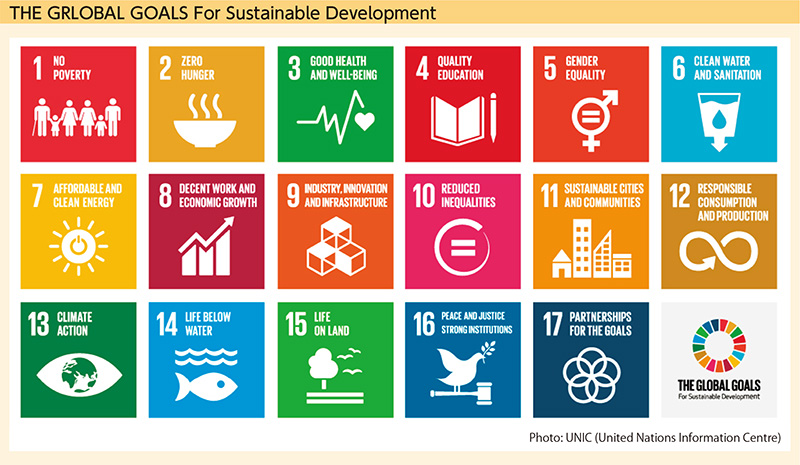Diplomatic Bluebook 2016
Chapter 3
Japan’s Foreign Policy to Promote National and Worldwide Interests
1.Development Cooperation (ODA, etc.)
(1) Establishment of the Development Cooperation Charter and the Current Status of ODA
A. Establishment of the Development Cooperation Charter and the current status of ODA
In February 2015, Japan’s ODA Charter was revised for the first time in 12 years and the new “Development Cooperation Charter” was approved by the Cabinet. Based on the philosophy that has been formed over more than 60 years of Japan’s ODA history, the New Charter designates the following three basic policies to be pursued in the future: (1) contributing to peace and prosperity through cooperation for non-military purposes, (2) promoting human security, and (3) cooperation aimed at self-reliant development through assistance for self-help efforts as well as dialogue and collaboration based on Japan’s experience and expertise. Japan plans to further develop these policies. In line with these basic policies, the following priorities are set out.
(a) “Quality Growth” and poverty eradication through such growth
The achievement of economic growth through self-sustaining development in developing countries and growth in the private sector is essential for poverty eradication. In addition, economic growth should not be merely quantitative in nature but also “Quality Growth.” Such growth is “inclusive” in the sense that the fruits of growth are shared within society as a whole leaving no one behind. It is “sustainable” over generations in terms of consideration to, among other aspects, harmony with the environment, sustained socioeconomic growth, and addressing global warming. And it is “resilient,” to be able to withstand and recover from economic crisis, natural disasters and other shocks. Therefore, Japan provides necessary support such as industrial foundation development, the introduction of advanced technologies, and human resources development.
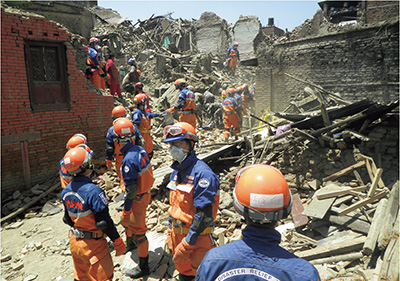 Activities of JDR rescue teams in Nepal. (Photo: JICA)
Activities of JDR rescue teams in Nepal. (Photo: JICA)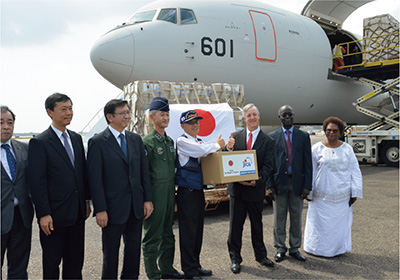 Provision of Emergency relief in response to Ebola virus disease outbreak in the West Africa (delivery of personal protective equipment (PPE) transported by a Self-Defense Force Air plane)
Provision of Emergency relief in response to Ebola virus disease outbreak in the West Africa (delivery of personal protective equipment (PPE) transported by a Self-Defense Force Air plane)(Photo: Ministry of Defense)
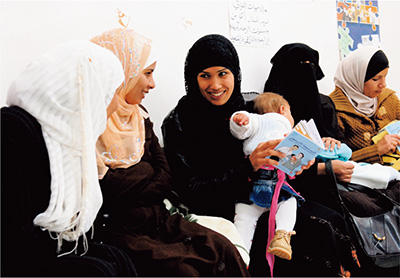 Mothers exchanging information with Maternal and Child Health handbooks distributed by the Government of Japan at the health center waiting room in a refugee camp. (Photo: Imamura Kenshiro, JICA)
Mothers exchanging information with Maternal and Child Health handbooks distributed by the Government of Japan at the health center waiting room in a refugee camp. (Photo: Imamura Kenshiro, JICA)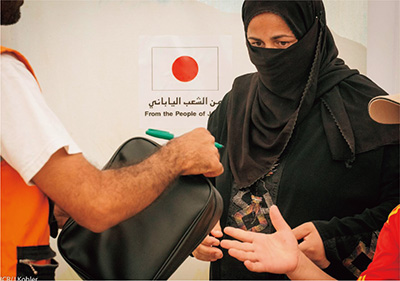 Support for Syrian refugees (distribution of daily necessities in Jordan)
Support for Syrian refugees (distribution of daily necessities in Jordan)(Photo: UNHCR)
(b) Sharing universal values and realizing a peaceful and secure society
Stable development through “quality growth” will not be achieved unless the rights of individuals are guaranteed, people can engage in economic and social activities with a sense of safety, and that the society is managed equitably and stably. With a view to solidifying the foundations for such achievement, Japan has provided assistance so as to share universal values such as freedom, democracy, respect for basic human rights and the rule of law as well as to realize a peaceful, stable, and secure society.
Securing peace, stability, and safety is a precondition for the creation of a country. From this viewpoint, Japan comprehensively addresses various factors including poverty, conflicts, and instability as well as supporting seamless peace-building, from emergency humanitarian assistance after conflict to recovery, reconstruction, and development.
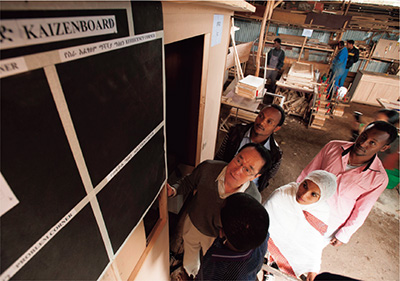 A production site working on kaizen (improvement) as one of the engines of high economic growth in Japan that brought positive changes to many production sites. (Photo: Imamura Kenshiro, JICA)
A production site working on kaizen (improvement) as one of the engines of high economic growth in Japan that brought positive changes to many production sites. (Photo: Imamura Kenshiro, JICA)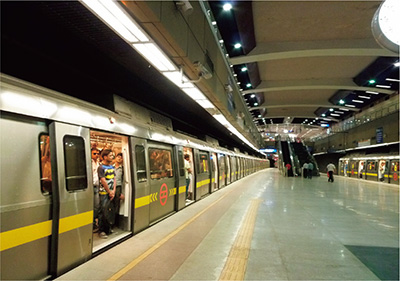 Delhi Metro in India constructed by yen loan. The number of passengers a day is over 2.5 million. The metro contributes to the economic growth and mitigation of traffic congestion in India
Delhi Metro in India constructed by yen loan. The number of passengers a day is over 2.5 million. The metro contributes to the economic growth and mitigation of traffic congestion in India(c) Building a sustainable and resilient international community through efforts to address global challenges
Global issues cannot be settled by only one country. Regions and the international community must work together. Japan takes the lead to address global issues including reflecting Japanese development cooperation philosophy including human security in the “2030 Agenda for Sustainable Development” adopted by the UN in September, and aims for building a sustainable and resilient society in the entire international community, such as through the promotion of measures against climate change and infectious diseases, UHC1 and mainstreaming of disaster risk reduction.
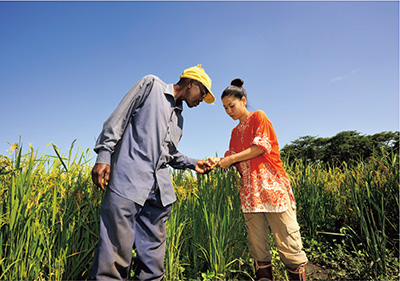 A Japan Overseas Cooperation Volunteer working to increase the income of farmers as “Japan’s visible assistance” (Photo: Koji Sato, JICA)
A Japan Overseas Cooperation Volunteer working to increase the income of farmers as “Japan’s visible assistance” (Photo: Koji Sato, JICA)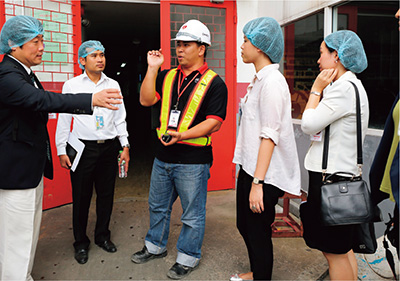 Institute of Cambodia of Technology (ICT) implemented joint research with a Cambodian soft drink manufacturer with collaboration from Japanese experts (Photo: Satoshi Takahashi, JICA)
Institute of Cambodia of Technology (ICT) implemented joint research with a Cambodian soft drink manufacturer with collaboration from Japanese experts (Photo: Satoshi Takahashi, JICA)- 1 The goal of UHC is to ensure that all people obtain the basic health services they need.
B. Priority Policy for Development Cooperation
Development cooperation is one of the most important diplomatic tools of Japan in dealing with changing circumstances surrounding it and in promoting the principle of “Proactive Contribution to Peace” based on the principle of international cooperation. For strategically and effectively promoting development cooperation, the Ministry of Foreign Affairs (MOFA) placed the following four points as part of the FY2015 priority policy.
In February 2015, the Official Development Assistance (ODA) Charter was revised, and the Development Cooperation Charter was approved by the Cabinet.In the new Charter, the “Promotion of the understanding of the people and the international community” is included. Amid Japan’s severe financial situation, efforts for obtaining the people’s understanding and support for ODA are increasingly important.
Initiatives in Japan
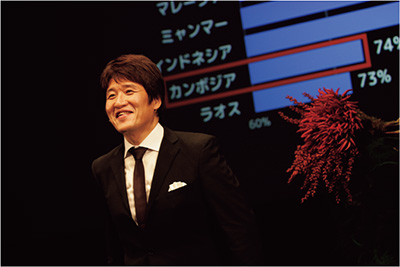 Mr. Osamu Hayashi explaining development cooperation in the TV program entitled “Our first step to open up the world by Osamu Hayashi”
Mr. Osamu Hayashi explaining development cooperation in the TV program entitled “Our first step to open up the world by Osamu Hayashi”We continued to make efforts for disseminating and explaining ODA in 2015, through the website and various media.In particular, Japan’s largest international cooperation event, the “Global Festa JAPAN 2015” held in October, is one of the most important opportunities to sensitize the public about the international cooperation. In 2015, under the theme of “Share the Happiness! Expand from Odaiba! A chain of international cooperation full of happiness,” participatory-oriented events with exhibitions, stage events, workshops and stamp rallies were organized by 274 non-governmental organizations (NGOs), international organizations, embassies in Tokyo and business enterprises. As a special project, the Ministry of Foreign Affairs also organized a photo exhibition entitled “Let’s make the world HAPPY together! From the happiness source.”116 photos were exhibited showing Japanese people and Japanese organizations (NGOs, businesses and public institutions, etc.) involved in activities for international cooperation all over the world, which provided the visitors with an opportunity to know more about international cooperation. Various events and exhibitions were held at the Ministry of Foreign Affairs’ booth to deepen the understanding of international cooperation through quizzes and lucky draws.
Further, in order to deepen the people’s understanding of development cooperation, a TV program entitled ‘Our first step to open up the world’ by Osamu Hayashi” was aired through a network of six TV TOKYO-associated stations, in which an easy-to-understand introduction was given on the current situation of development issues around the world, how can individuals get involved and the philosophy of Japan’s cooperation, etc.
Initiatives abroad
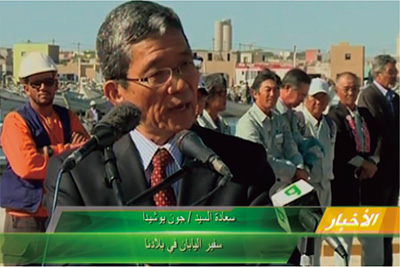 Ambassador Yoshida giving a speech during a press tour in Mauritania
Ambassador Yoshida giving a speech during a press tour in MauritaniaWe are promoting efforts in and outside of Japan.To promote the “visibility” of Japanese development cooperation, we arranged press tours in 15 countries, where local media-related people visited local sites accompanied by the Japanese embassy staff, thereby getting Japan’s development cooperation covered by the local media. After the press tour in Mauritania, well known for its exports of octopuses, the media covered a story, for instance, reporting on the relationship between Japan’s cooperation and the fisheries sector, which is important for the Mauritanian economy. We also made pamphlets about Japan’s cooperation in local languages. The pamphlets, which give an easy-to-understand description of the history and philosophy of bilateral cooperation and individual projects, are distributed to a variety of people, including government officials of the partner countries and the press.
In order to make the most of official development assistance (ODA), which is one of the most important diplomatic means of Japan, we will continue to focus on public relations.
(a) Cooperation to share universal values and promote international peace and stability
Japan provides support including the development of legal systems, strengthening governance, as well as gender equality in order to support efforts by countries sharing universal values such as democracy, the rule of law, and human rights and strengthen their relationship with Japan. Moreover, Japan also actively contributes to the peace and stability of the international community through assistance for such as peace-building, counter-terrorism and -organized crime, and enhancing maritime law enforcement capabilities.
(b) Enhancing strategic development cooperation for the economic growth of developing countries and Japan
Japan supports developing counties in achieving “quality growth.” At the same time, Japan supports such areas as the overseas operation of local governments and small and medium-sized enterprises (SMEs), exporting infrastructure system, the improvement of business environments, promoting overseas business regarding medical technologies and services, to contribute to Japan’s economic growth and regional revitalization in Japan.
(c) Promoting human security
Taking into the consideration the Third United Nations World Conference on Disaster Risk Reduction and the formulation of the “2030 Agenda for Sustainable Development,” Japan provides assistance in the areas of disaster risk reduction/disaster recovery, health, measures against environmental problems and climate change, poverty reduction, education, etc., in collaboration with international organizations. These efforts are based on the philosophy of human security.
(d) Building strategic partnership
Japan enhances relations with so-called “ODA graduates” including Small Island Developing States (SIDS) with particular vulnerabilities and emerging countries, which serve as important investment destinations for Japanese companies, as well as region-wide assistance in collaboration with local organizations, etc. Moreover, Japan enhances the opportunities for public participation through cooperation with NGOs and volunteer programs, etc.
(2) Japan’s Development Cooperation Performance and Approaches to Major Regions
A. Japan’s ODA Performance
Japan has provided a total of about 463.5billion US dollars in ODA. Japanese major forms of ODA are grant aid, namely, bilateral fund donations; loan aid for development in developing regions; technical cooperation; donation or contribution to international organizations, etc. Loan aid accounts for the largest percentage. Japan has provided loan aid worth approximately 204.8 billion US dollars, which are usually repaid with interest. Japan’s ODA performance in 2014 in terms of total disbursements was about 15.71 billion US dollars, down 30.3% from the previous year. Japan ranks fourth among 28 member states of the Organization for the Economic Co-operation and Development/Development Assistance Committee (OECD/DAC), following the United States, the United Kingdom, and Germany. In terms of net disbursements, which are generally used for international comparison, the amount is about 9.27 billion US dollars, down 20.0 % from the previous year, ranking fifth after the U.S., UK, Germany, and France. The ODA/GNI ratio based on net disbursements was 0.19%, ranking 18th among member states of the DAC.
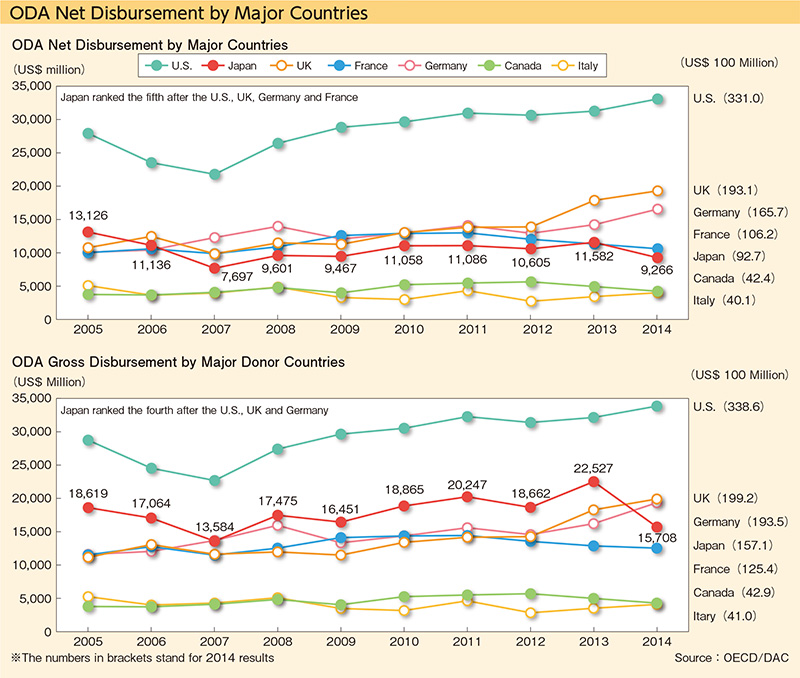
B. Approaches to Major Regions
(a) Asia
The peace, stability, and prosperity in the East Asian region are important to Japan, which has a close relationship with the region. Japan has created momentum toward solutions for various development issues, including poverty reduction, by promoting economic development and human security in the region and also contributed to its development.
Approximately 58.3% of the total bilateral ODA of Japan went to this region in 2014. Most of it is support for ASEAN countries. Considering that support for infrastructure building and training of industrial human resources to strengthen regional connectivity and industrial foundation development are essential to sustainable growth in the region, Japan announced “Partnership for Quality Infrastructure” in collaboration with the Asian Development Bank (ADB) to provide quality infrastructure investment of approximately 110 billion US dollars to Asia over the next five years in May 2015, and its follow-up measures in November 2015. Japan also announced the “Industrial Human Resource Development Cooperation Initiative” to develop 40,000 industrial human resources over the next three years at the ASEAN-Japan Summit in November 2015. Japan will continue to support Asian sustainable growth covering both “hard” and “soft” aspects. Furthermore, ASEAN countries are extremely important for Japan both politically and economically: they share universal values and have the close economic ties such as advancement of many Japanese companies. The further integration, stability, and prosperity of ASEAN countries are important to the stability and development of Japan and the region. Based on this recognition, Japan securely implements ODA support in many areas, such as enhancement of the rule of law, maritime security, disaster risk reduction, health/medical care, peace-building, etc., aiming at enhanced connectivity and a narrowing of the development gap.
For the Mekong region, the New Tokyo Strategy 2015 for Mekong-Japan Cooperation was adopted at the Mekong-Japan Summit Meeting in July. Japan announced 750 billion yen would be provided through ODA over the next three years. With this support, Japan seeks the realization of “Quality Growth” in inclusiveness, sustainability, and resilience in this region.
The economy has developed in South Asia, but many issues such as undeveloped infrastructure and poverty still remain unsolved. While also keeping in mind improving the investment environment for Japanese companies and human security, Japan provides a range of assistance through ODA to assist the region in overcoming these challenges.
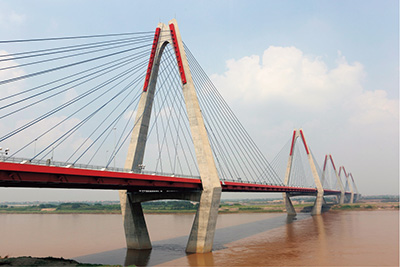 The Nhat Tan Bridge in Vietnam greatly reduced the time required from the international airport in Hanoi to the urban areas of Hanoi.
The Nhat Tan Bridge in Vietnam greatly reduced the time required from the international airport in Hanoi to the urban areas of Hanoi.(Photo: JICA)
Especially for India, the largest democratic country in the world, Japan’s ODA is expected to contribute to the further promotion of economic and social development there and economic cooperation between the two countries. The Japan-India summit meeting in December confirmed the usage of the Japanese Shinkansen system in the Mumbai-Ahmedabad high-speed railway. On the other hand, as India’s balanced growth leads to the stability in South Asia, Japan supports Basic Human Needs (BHN) such as health, medical care, education, and agriculture aiming at poverty alleviation and the solution to inequality.
In response to the major earthquake in Nepal in April, Japan dispatched a Japan Disaster Relief (JDR) Teams and provided emergency humanitarian assistance and also expressed its commitment to delivering more than 32 billion yen in total of assistance in the area of rebuilding schools, houses, and public facilities for “Build Back Better” of the country at the International Conference on Nepal’s Reconstruction in Nepal’s capital Kathmandu in June (see 2-1-4).
(b) Central Asia and the Caucasus
The Central Asia and the Caucasus are geopolitically important areas surrounded by Russia, China, South Asia, the Middle East, and Europe. Its stability and development are important for all in the whole Eurasia, including Japan. From this viewpoint, Japan supports the nation building so that universal values such as human rights, democracy, market economy, and the rule of law can take root for long-term stability and sustainable development in this region with broad-based views covering neighboring regions including Afghanistan and Pakistan in mind.
In October, Prime Minister Abe visited five Central Asian countries and announced strengthening of relationships with three pillars: dramatic strengthening of bilateral relations, involvement in regional common issues, and cooperation in the global arena. As for the area of development cooperation, he expressed cooperation not only to the building of economic/social infrastructure such as roads, airports, and medical care, but also to highly skilled industrial human resource development by using Japanese style engineering education such as colleges of technology, and continuous support to young government officials’ study in Japan, as well as to Japan Centers. In addition, he confirmed continuous cooperation on major issues of the “Central Asia + Japan” Dialogue: border management, counter narcotics, agriculture, and others (see 2-5-2).
(c) The Middle East
Securing peace and stability in the Middle East/North Africa regions, which are geopolitically important and important for energy security, is crucial to the world’s stability. From these standpoints, Japan has proactively provided support for these regions to achieve peace and stability. In light of the serious humanitarian crisis in Syria, where the situation is worsening, with 6.5 million internally displaced persons and over 4.3 million refugees outside Syria, Japan expressed a commitment at the UN General Assembly in September to deliver aid worth approximately 810 million US dollars to Syrian and Iraqi refugees, internally displaced persons, and neighboring countries. In implementing support, consideration in line with the principles of human security has been made in particular to the most vulnerable, such as women and children, in such areas as education, water, and health/sanitation.
As for Iraq, Japan has accomplished the commitment totaling five billion US dollars of assistance for Iraq’s reconstruction by May 2012 that had been pledged at the International Donors’ Meeting for Reconstruction in Iraq in 2003. By FY2014, Japan had accepted approximately 6,500 Iraqi trainees. Japan will continue to provide support Iraq for the realization of the self-reliant development.
Furthermore, Japan and the international community are providing support to promoting Afghanistan’s self-reliance and the stability of the region in order to prevent Afghanistan from stepping back into a hotbed of terrorism. Japan provided a total of about 5.9 billion US dollars from 2001 to December 2015, in development assistance mainly in the three areas of improvement of security capabilities, reintegration of anti-government militias into society, and support for sustainable development.
(d) Africa
Sub-Saharan Africa has achieved remarkable growth against a background of rich natural resources and population growth and attracted expectations and attention of the international community, and increased its presence as the growth center of the world since the 2000s. Under these circumstances, the 5th Tokyo International Conference on African Development (TICAD V) on the theme of “Hand in Hand with a More Dynamic Africa” was held in June 2013. Japan announced a boost to Africa’s growth through ODA support of approximately 1.4 trillion yen over the next five years under the basic policy of promoting “human security” as well as the promotion of private trade and investment. Japan is now committed to the steady implementation of that support.
In the meanwhile, Sub-Saharan Africa still has problems of poverty, economic disparities, slow development of infrastructure, low agricultural productivity, shortfalls in industrial human resources, and an economic structure centering on primary products. New issues have become visible including through recovery from the unprecedented outbreak of Ebola virus disease and the rise of violent extremists. To solve such issues as these, new efforts have started, such as the adoption of Agenda 2063, the fundamental principle of development/poverty reduction for the next 50 years in Africa at the African Union (AU) Summit in January. Japan held the Third Japan–African Regional Economic Communities (RECs) Summit Roundtable in New York in September, where Prime Minister Abe expressed the support toward Africa based on these approaches.
Responding to wishes of Africa, at the 2014 UN General Assembly Prime Minister Abe announced the next TICAD would be held in Africa. It was formally decided that TICAD VI would be held in Kenya in August 2016. The next TICAD VI will be a good opportunity to widely inform African people of Japan’s unique contribution. Japan will send a strong message about its intention to vigorously boost Africa’s “quality growth” through efforts that make the most of Japanese strong points such as human resource development and high-quality infrastructure investment, from the viewpoint of “human security” focusing on each person.
(3) Approaches to appropriate and effective implementation of ODA
In the process of ODA implementation, it is extremely important to actively disclose information to the public and ensure transparency at each stage, from project planning, implementation, and post-implementation evaluation and follow-up so as to make the aid more effective and efficient.
A. Approaches to Appropriate Implementation of ODA
Prior to the implementation of research for formulating new projects of grant aid, loan aid and technical cooperation, the Development Project Accountability Committee conducts opinion exchanges regarding the contents of research among external experts and relevant departments of MOFA and JICA to further increase the effectiveness and enhance the transparency of ODA projects.
A fraudulent or dishonest action related to ODA projects would not only impede appropriate and effective implementation of assistance but also damage the trust of the people in ODA projects. This is absolutely intolerable. Regrettably, cases of illegality and corruption associated with ODA occurred in 2014. In response, MOFA and JICA have decided to reinforce the information desk on illegality and strengthen measures against corporations involved in illegal actions.
B. Approaches to Effective Implementation of ODA
In order to provide effective and efficient assistance based on the issues and needs of the recipient country, Japan has formulated individual assistance policies for each country. In principle, these policies shall be developed for all the recipient countries, and policies for 110 countries have been formulated as of December 2015.
Japan is making efforts to enhance its Program Approach to implement effective and concrete ODA projects tailored to specific goals by setting up a goal for the solution of specific development issues through consultation with the recipient country.
In addition to these measures, the introduction of a more systematic numerical target into project-type grant aid from the perspective of enhancing the PDCA cycle2 has been selected as one of the Good Practices in project improvement by the Administrative Reform Promotion Council in June 2014.
In the “Global Partnership for Effective Cooperation (GPEDC)”, efforts are made to improve the effects of the development cooperation under the inclusive participation of various main actors such as the civil society and the private sector as well as developed and developing countries. Japan became a GPEDC Steering Committee member in September 2015 and has contributed to improving effects of development cooperation based on its own experience.
- 2 Cycle of preparation, implementation, evaluation, and improvement
C. Efforts toward Promotion of ODA Information Disclosure and Improvement of Quality
The understanding and support of the people of Japan is essential for the implementation of ODA and, therefore, efforts are made for effective communication and the improvement of ODA quality to enhance their understanding of ODA. Various PR events took place aiming to reach out to a wide range of people. Specifically, participatory type events such as “Global Festa JAPAN 2015,” Japan’s largest event for international cooperation, held in Tokyo in October and “One World Festival” in Osaka in February were held. In addition to these, a TV publicity program (“Osamu Hayashi’s‘Sekai wo Hiraku Bokura no Ippo (Our First Step to Open the World)’ ” was broadcasted to present some examples of international cooperation activities conducted by Japan all over the world and explain the meaning of development cooperation for Japan in an easy-to-understand manner presenting the reports on ODA sites in developing countries. Also, efforts are continuously made to deliver information on development cooperation through ODA web site. Furthermore, based on the Development Cooperation Charter, which declares making enhanced efforts to disseminate information abroad, Japan plans site-visit tours to Japan’s development cooperation projects for the local media to provide opportunities for them to address Japan’s cooperation, and prepare PR pamphlets in English and local languages.
In order to raise the quality of ODA, it is necessary to apply the knowledge and know-how obtained from ODA evaluations to subsequent policy planning and project implementation. MOFA carries out evaluations through external experts, and uses and shares the evaluation results among the relevant parties. Also, from the viewpoint of improving transparency of JICA’s projects, the current status and achievements of projects are made available on the “Visible ODA” section of JICA’s website. As of the end of December 2015, a total of 3,379 projects are listed on this site.
